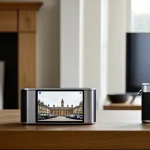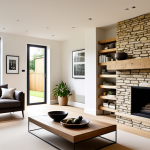Creating a Safe and Pet-Proofed Environment
Keeping a home safe for pets requires pet-proofing that targets common hazards found in UK households. Many pets, driven by curiosity, can get into dangerous situations with everyday items. For example, unsecured cables pose a dangers for pets risk, as chewing on them can lead to electrical shocks or burns. It is essential to tuck cables neatly behind furniture or use cable protectors designed specifically for pet safety.
Bins are another frequent hazard. Many UK homes use bins without secure lids, tempting pets to rummage through potentially harmful waste. Using bins with child-proof locks available from UK suppliers can prevent pets from accessing dangerous contents like food scraps or cleaners.
Also read : How Do You Choose the Perfect Pet for Your Lifestyle in the UK?
Breakables such as glass ornaments or fragile kitchenware need protection by either placing them out of reach or behind barriers. Leveraging UK-sourced child-proof locks and barriers can restrict pets’ access to kitchens or utility rooms where cleaning chemicals or fragile items are common.
By understanding the typical risks within a UK home and incorporating these practical pet-proofing measures, pet owners create an environment that supports ongoing pet safety while reducing stress caused by constant supervision and worry. This strategic approach benefits both pets and household members, ensuring peace of mind in a safely secured home.
Also to read : What are the latest UK trends in pet nutrition?
Selecting Comfortable Bedding and Furniture for UK Pets
Choosing the right pet bedding UK options greatly impacts pet safety and comfort. The UK climate, with its fluctuating temperatures and damp conditions, demands bedding that provides warmth and moisture resistance. Natural fibers like cotton and wool are favourable for airflow and insulation, helping maintain a comfortable temperature for dog beds and cat beds throughout the year.
When it comes to pet furniture, selecting pieces from reputable UK brands ensures quality and durability. Many UK pet furniture shops offer designs tailored to both urban and rural homes, accommodating space constraints and specific pet needs. Considerations such as washable covers and non-toxic materials enhance safety, reducing allergens and enabling easy cleaning.
Placement of bedding is crucial. Positioning beds away from draughts, ideally in quiet corners with gentle sunlight exposure, creates a secure retreat for pets. Elevated beds can protect smaller animals from cold floors common in many UK homes. Incorporating soft cushions and supporting structures aligns with pet safety principles by reducing joint strain and promoting restful sleep.
In summary, selecting comfortable pet beds and furniture suited to the UK climate, combined with thoughtful placement, fosters a safe and cozy environment. This intentional approach supports pets’ physical health and emotional wellbeing in every season.
Adapting to the UK Climate: Heating, Cooling, and Draft Protection
Adapting a home to the UK climate is vital for maintaining optimum pet safety and comfort throughout the year. British weather is known for its variability, with cold, damp winters and sometimes hot, humid summers, making seasonal pet care a key consideration. Ensuring consistent warmth during chilly months helps prevent illnesses linked to cold exposure, especially in smaller or older pets.
To address home heating for pets, gently heated areas such as heated pet beds or heat mats specifically designed for animal use can provide targeted warmth without risks tied to standard heaters. Heated products should have thermostats or automatic shut-offs to avoid overheating or burns. Placement away from direct heat sources or draughts is necessary for safe comfort.
On the flip side, pet cooling solutions become essential in rare but intense summer heat. Cooling mats, fans positioned safely and out of reach, and breathable bedding materials help regulate pets’ body temperatures. Proper hydration and shaded resting places further reduce heat stress.
Older UK homes often suffer from draughts, a common danger for pets that leads to discomfort or illness. Simple measures to protect pets from drafts include installing draft excluders on doors and windows, and positioning bedding in naturally sheltered spots. Pet-safe barriers and curtains can also block cold air flow without restricting access.
By integrating these measures, pet owners can mitigate the climate-related hazards present in UK homes. This proactive approach, focusing on appropriate heating, cooling, and draft protection, enhances overall pet safety and wellbeing regardless of seasonal changes.
Facilitating Safe Indoor and Outdoor Access
Ensuring safe garden access and installing proper pet doors UK are critical for responsible pet ownership. Secure dog doors and cat flaps specifically designed for UK homes offer pets independent entry and exit while minimizing risks of escape or unwanted intruders. When selecting these doors, focus on models with locking mechanisms and size-appropriate openings for your pet’s breed and age.
Making gardens escape-proof begins with inspecting fences and gates for gaps or weak points. Reinforcing boundaries with pet-safe netting or barriers prevents pets from wandering into hazardous areas or onto busy roads. Keep in mind that some UK local councils have rules concerning garden security for animals, so compliance is important to avoid fines.
For outdoor pets, consider factors like exposure to traffic, wildlife, and harmful plants common in UK gardens. Providing shaded resting spots and fresh water encourages safe spending of time outdoors. Additionally, maintaining the garden free from toxic substances like slug pellets or garden chemicals supports overall outdoor safety for pets.
Navigating local laws and neighbourhood considerations is essential, especially in shared housing or rural areas. Some UK neighbourhoods have restrictions on letting pets roam freely or require certain containment measures. Consulting local animal welfare organisations or websites can clarify these rules to align your garden’s safety features accordingly.
By integrating carefully chosen pet doors UK solutions with robust garden security and an awareness of community guidelines, pet owners build an environment fostering freedom, exercise, and safety for their pets both inside and out.
Creating a Safe and Pet-Proofed Environment
In any UK home safety for pets begins with identifying everyday hazards common to British households. Many pets are naturally curious, which can lead them into dangerous situations. Pet-proofing efforts should prioritize securing loose cables, as pets chewing on them risk severe electrical injuries. Cables can be safely tucked away using cable management solutions designed for pet safety, reducing this frequent danger for pets.
Bins present another typical household risk. Many standard bins lack secure lids, inviting pets to access harmful waste, spoiled food, or cleaning chemicals. Employing bins with child-proof locks sourced within the UK can effectively block these access points, supporting safer waste management for pets.
Fragile items such as glass ornaments and kitchenware require protection. Using UK-sourced child-proof locks or barriers to restrict access to areas containing breakables or toxic substances prevents accidental harm to pets. Installing such barriers around kitchens or utility rooms safeguards pets from exposure to dangerous materials.
By systematically addressing these hazards—securing cables, locking bins, and protecting delicate or toxic items—owners create a fortified environment that minimizes common threats. This approach not only promotes ongoing pet safety but eases the burden of constant supervision, fostering a more relaxed and secure home atmosphere for pets and humans alike.
Creating a Safe and Pet-Proofed Environment
Creating a truly safe home for pets requires a thorough approach to pet-proofing, focusing on eliminating everyday dangers for pets common in UK households. One fundamental step is securing electrical cables. Pets often find cables appealing to chew, risking serious injury such as shocks or burns. Using cable covers or conduits specifically designed for pet safety prevents access and reduces these hazards significantly. Properly routing cables behind furniture or along walls is another effective method to keep them out of reach.
Bins represent another major concern in the realm of UK home safety for pets. Many typical household bins lack secure lids, making them attractive for curious animals eager to scavenge for food or investigate smells. This can expose pets to toxic substances or sharp objects. The use of UK-sourced child-proof locks on bins is a practical and reliable way to grant bins more secure closure, preventing pets from gaining entry and encountering dangerous contents.
Protecting breakable and potentially harmful items is equally essential. Glass ornaments, delicate kitchenware, or cleaning supplies located in reachable spaces pose threats if knocked over or chewed. Installing barriers or gating off kitchens and utility rooms with child-proof locks sourced in the UK helps restrict pet access to these sensitive areas. This not only preserves the household environment but importantly enhances pet safety by preventing accidental ingestion or injury.
By implementing these specific safety measures—cable management, bin security, and area barriers—pet owners address primary household hazards efficiently. This focused pet-proofing safeguards physical health and reduces the stress associated with constant pet supervision, fostering a safe and calm atmosphere in UK homes.
Creating a Safe and Pet-Proofed Environment
Ensuring UK home safety for pets starts with identifying common dangers for pets found within typical British households. One primary hazard involves unsecured electrical cables. Pets chewing on exposed wires risk serious injury, including shocks and burns. Effective pet-proofing includes enclosing cables in protective covers or conduits designed specifically for animals, or routing cables behind furniture to keep them out of reach.
Bins also pose notable risks, as many UK homes use standard bins without secure lids, tempting pets to access harmful waste or chemicals. Installing UK-sourced child-proof locks on bins creates a reliable barrier, blocking pets from rummaging through contents that could be toxic or physically dangerous.
Fragile items such as glass and ceramics, as well as cleaning products, require additional protection. Preventing pet access through barriers or gating sensitive areas like kitchens and utility rooms is essential. Utilizing child-proof locks sourced within the UK to secure these barriers enhances pet safety by blocking entry to zones containing breakables or toxic substances.
By focusing on these vital elements—cable management, bin security, and restricted access to hazardous areas—pet owners effectively reduce prevalent household risks. This focused pet-proofing strategy ensures a safer environment, giving pets freedom while alleviating owners’ concerns about potential accidents.





